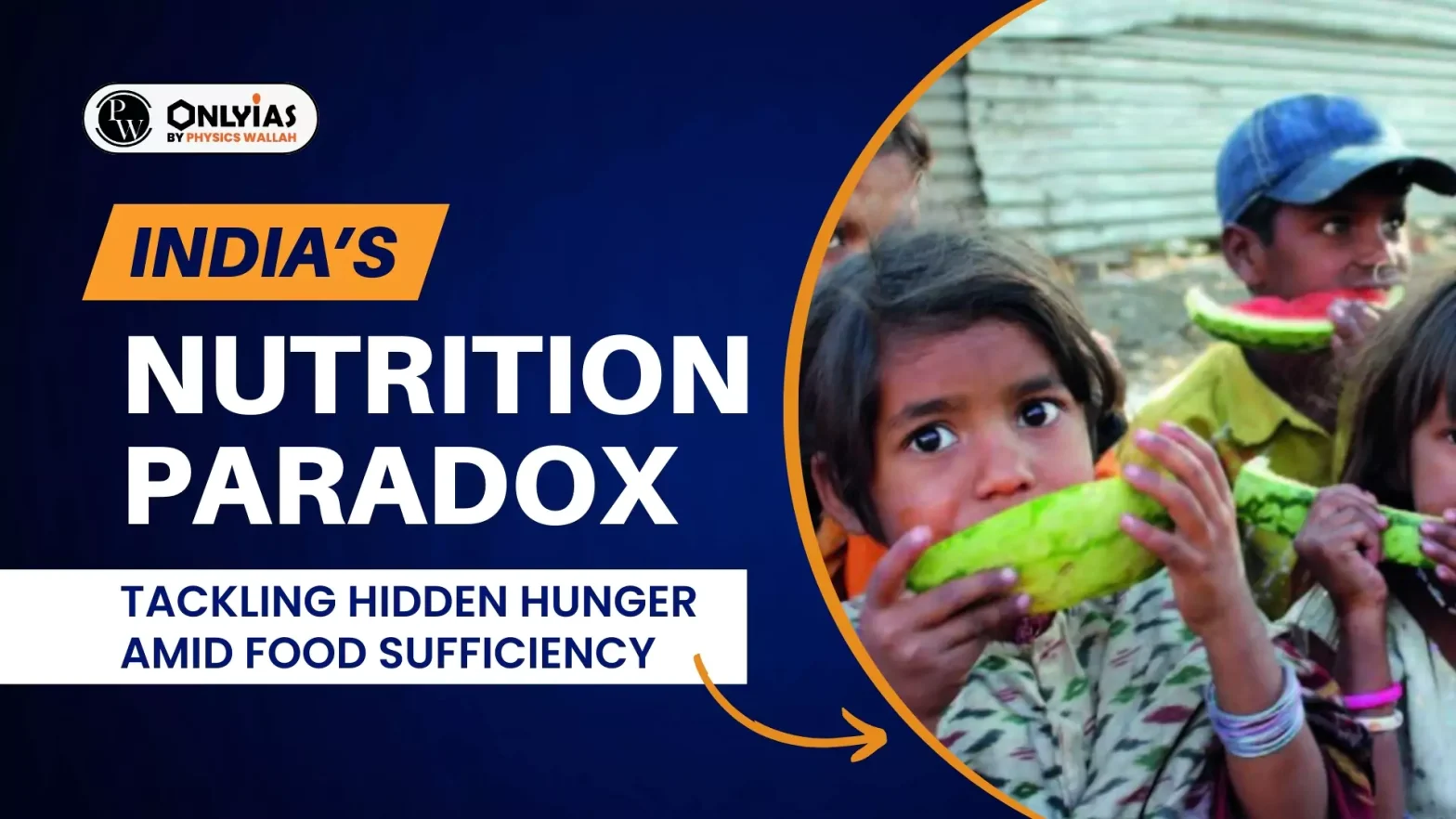The Global Hunger Index 2023 ranks India 111th out of 125 countries, highlighting that malnutrition, stunting and micronutrient deficiencies remain widespread.
What is the Nutrition Paradox?
- India has achieved self-sufficiency in food production and even export food yet the problem of hunger persists in India.
- Issues like undernutrition and hidden hunger persists in India. The Global Hunger Index (GHI) 2023 ranks India 111th out of 125 countries.
Enroll now for UPSC Online Course
| Hidden hunger, or micronutrient deficiencies, occurs when the quality of food that people eat does not meet their nutrient requirements, so they are not getting the essential vitamins and minerals they need for their growth and development. |
- The Global Hunger Index (GHI) 2023 ranks India 111th out of 125 countries.
- The National Family Health Survey (NFHS-5, 2019-2021) shows that undernutrition persists—35.5 percent of children under five are stunted, and 19.3 percent suffer from wasting.
| Child Wasting: The share of children under age five who have low weight for their height, reflecting acute undernutrition.
Child Stunting: The share of children under age five who have low height for their age, reflecting chronic undernutrition. |
Reasons that Exacerbate Food Insecurity and Hidden Hunger
- Income Disparity: Income disparities exacerbate food insecurity in certain regions. Many people due to poverty cannot afford sufficient food, leading to chronic hunger.
- Lack of awareness regarding sources of nutrients could be the reason for hidden hunger among the rich.
- Gender Inequality
- Limited healthcare access
Check Out UPSC Modules From PW Store
Solution: Community-Led Nutrition Hubs
- Local Knowledge and Leadership: Community-led nutrition hubs provide a grassroots solution to food insecurity by leveraging local knowledge and leadership.
- These hubs focus on sustainable, context-specific approaches, promoting balanced diets tailored to geographical needs, prioritising nutrition over mere caloric intake for healthier communities.
- Balanced and Diverse Diet: Nutrition hubs encourage the consumption of diverse foods, including fruits, vegetables, legumes, and animal products, essential for a balanced diet.
- Supporting Vulnerable Groups: These hubs effectively reach vulnerable populations like children, pregnant women, poor and the elderly.
- They provide tailored nutritional support, fortified foods, supplements, and education on specific nutritional needs.
| Fortified foods are those that have nutrients added to them that don’t naturally occur in the food. |
- Leveraging Local Agriculture: Such hubs could promote and support local food production and sustainable agricultural practices, increasing access to fresh, nutritious foods.
- This would reduce dependency on external support. This would also reduce the price which often increases due to transportation.
- Impact of Community-Led Nutrition Hubs: As per Food and Agriculture Organisation (FAO) there was a 20 per cent reduction in stunting rates among children under five in regions of Uttar Pradesh following the introduction of nutrition hubs.
Other Solutions
- Men as Partner (Gender Equity): Often the burden of nutrients and food security lie on the women. Men should also participate in nutrition hubs, whether through farming, cooking, or community organising.
- Youth Engagement: Involving young people in these efforts ensures the continuation of community-led initiatives. Youth are able to bring fresh ideas and energy to the table.
- Local Government Support: Local governments can support and scale these initiatives by providing funding, policy support, and infrastructure, making nutrition hubs integral parts of community development.
Enroll now for UPSC Online Classes
Conclusion
Achieving the vision of a “Viksit Bharat” requires ensuring food security and building resilience through community-led initiatives. A whole-of-society approach, involving all members, is essential to create a balanced and inclusive future for all.
![]() 11 Oct 2024
11 Oct 2024

